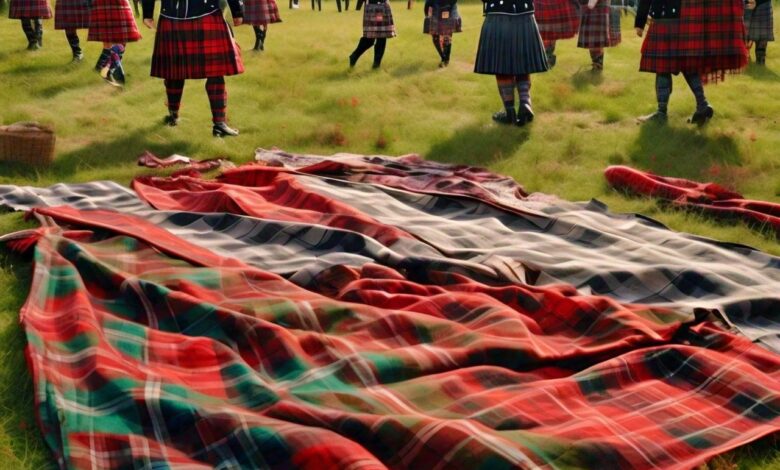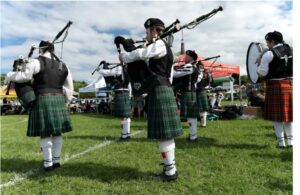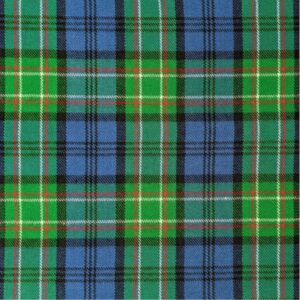The Role of Allen Tartan in Scottish Plaid Tartan Tradition

In the rich tapestry of Scottish culture, few symbols are as iconic and enduring as tartan. This distinctive pattern, characterized by criss crossing horizontal and vertical bands in multiple colors, has become synonymous with Scotland itself. Within the vast array of tartans, each with its own unique design and history, one stands out for its significance and influence: Allen Tartan. This article delves into the role of Allen Tartan in the broader context of Scottish plaid tartan tradition, exploring its origins, evolution, and cultural significance.
Origins of Allen Tartan
The origins of Allen Tartan can be traced back to the ancient Celtic clans of Scotland, where tartan served as a means of identification and solidarity. The Allen clan, like many others, utilized tartan patterns to distinguish themselves from other clans and to foster a sense of unity within their own community. The specific design of Allen Tartan, characterized by its unique combination of colors and weave, likely evolved over centuries, influenced by the natural landscape of the region and the cultural heritage of the clan. Through the skillful craftsmanship of traditional weavers, the intricate patterns of Allen Tartan were meticulously created, reflecting the clan’s rich history and connection to the land.
The Evolution of Allen Tartan
Over the centuries, Scottish society underwent significant changes, and with it, the role of tartan within the culture evolved. What initially began as a practical means of identifying clan affiliation gradually transformed into a symbol of Scottish national identity. During the 18th and 19th centuries, a period marked by the romanticization of Scottish culture, tartan experienced a resurgence in popularity. Writers and artists, such as Sir Walter Scott, played a key role in promoting the romanticized image of Scotland, which included the iconic imagery of tartan-clad Highlanders. Allen Tartan, with its bold colors and intricate design, captured the imagination of both Scots and non-Scots alike, becoming a fashionable symbol of Scottish pride and heritage.
The Cultural Significance of Allen Tartan
Beyond its aesthetic appeal, Allen Tartan holds deep cultural significance within Scottish society. For many Scots, wearing Allen Tartan is more than just a fashion choice; it is a way of connecting with their ancestral roots and preserving their heritage. Whether worn as a traditional kilt or incorporated into modern attire, Allen Tartan serves as a tangible link to the past, reminding wearers of the resilience and traditions of their forebears. Moreover, Allen Tartan plays a practical role in modern Scottish life, often used to distinguish between various clans and families during special occasions and gatherings. This tradition not only honors the legacy of the past but also reinforces a sense of community and belonging among Scots around the world.
Preserving the Tradition
Despite the passage of time, the tradition of tartan weaving remains vibrant in Scotland. Today, numerous tartan mills and skilled artisans are dedicated to preserving and promoting this ancient craft. These craftsmen employ traditional techniques and high-quality materials to produce Allen Tartan and other traditional patterns, ensuring the continuation of Scotland’s rich weaving heritage. By maintaining the integrity of the craft, these artisans safeguard the legacy of Allen Tartan for future generations, perpetuating a tradition that is deeply woven into the fabric of Scottish culture. Furthermore, Allen Tartan has evolved to adapt to modern fashion trends while still honoring its heritage, proving its timeless appeal and enduring relevance in contemporary society.
The Symbolism of Allen Tartan
Beyond its practical and aesthetic functions, Allen Tartan carries deep symbolism within Scottish culture. Each color and pattern within the tartan holds significance, representing aspects of the clan’s history, values, and connection to the land. For example, earthy tones may symbolize the rugged landscapes of the Scottish Highlands, while bold hues could reflect the clan’s strength and resilience. Through the symbolism embedded in Allen Tartan, wearers not only honor their heritage but also express their identity and allegiance to their clan and homeland.
Influence on Global Fashion
While rooted in Scottish tradition, Allen Tartan has also made its mark on the global stage, influencing fashion trends and inspiring designers worldwide. The distinctive patterns and rich colors of Allen Tartan have been embraced by fashion houses and designers, appearing on runways and in collections around the world. From haute couture to streetwear, Allen Tartan continues to captivate audiences with its timeless elegance and undeniable allure, showcasing the enduring appeal of Scottish style and craftsmanship on an international scale.
The Role of Allen Tartan in Contemporary Scotland
In contemporary Scotland, Allen Tartan remains a ubiquitous presence, woven into the fabric of daily life. Beyond ceremonial occasions, tartan is embraced as everyday attire, worn with pride by Scots of all ages and backgrounds. Whether donned as a scarf, tie, or accessory, Allen Tartan serves as a subtle yet powerful symbol of Scottish identity and belonging. Moreover, the popularity of Allen Tartan extends beyond clothing, with the pattern adorning various household items and accessories, further embedding its significance into the cultural landscape of modern Scotland.
The Enduring Appeal of Scottish Tartan
Scottish tartan, with its timeless charm and rich history, continues to captivate audiences worldwide. The intricate patterns and vibrant colors of Scottish tartan serve as a testament to Scotland’s cultural heritage and craftsmanship. Each design, unique in its combination of colors and lines, represents different clans, regions, or historical events, weaving a story into the fabric itself. The allure of Scottish tartan lies not only in its visual appeal but also in its deep cultural significance. Wearing tartan is a way for individuals to connect with their ancestry and express their Scottish identity. Beyond traditional kilts and scarves, tartan has found its way into contemporary fashion, home decor, and even accessories, showcasing its remarkable versatility. The resilience of tartan in modern times highlights its enduring appeal and relevance. Designers and enthusiasts alike continue to explore and innovate with tartan, ensuring its presence in both heritage celebrations and everyday life. As a beloved symbol of Scottish pride, Scottish tartan transcends generations, fostering a sense of unity and continuity. Its enduring charm and historical richness ensure that the tradition of tartan will continue to thrive, celebrated and cherished by Scots and admirers around the globe for years to come.
Conclusion
In conclusion, Allen Tartan occupies a distinguished place within the illustrious history of Scottish plaid tartan tradition. From its humble origins in the ancient clans of Scotland to its enduring popularity in the modern world, Allen Tartan has remained a symbol of Scottish identity, pride, and craftsmanship. Through its intricate patterns and vibrant colors, Allen Tartan serves as a tangible link to Scotland’s rich cultural heritage, connecting generations past, present, and future in a shared celebration of Scottish culture. As long as there are Scots to wear it and artisans to weave it, the legacy of Allen Tartan will continue to thrive, ensuring that the spirit of Scotland endures for centuries to come.





